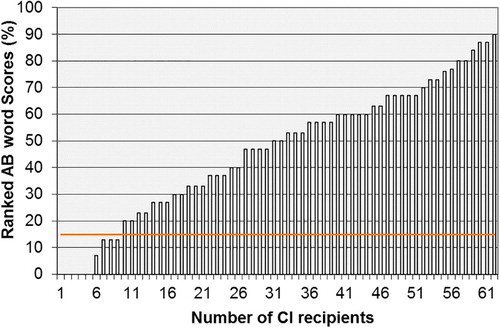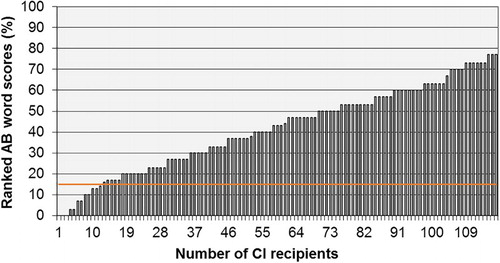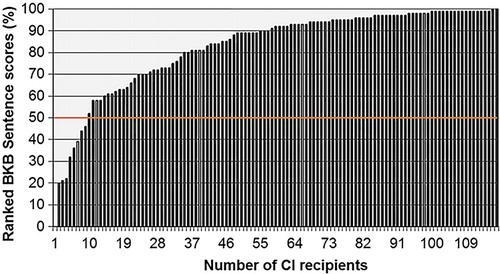Abstract
Rationale: Cochlear Implant (CI) candidates with a ski-slope hearing loss may be outside current implantation criteria [< 50% on Bamford–Kowal–Bench (BKB) sentence testing], despite having a significant hearing disability and limited benefit from conventional amplification.
Aim: To use existing post-operative performance data to establish a criterion for Arthur Boothroyd (AB) word test for CI candidacy assessment.
Methodology: Retrospective analysis of post-operative AB words scores for 64 CI users was performed and the 10th percentile score selected as a criterion of reasonable chance for post-operative improvement. A follow-up audit was performed 4 years later with a larger patient group of 127 CI users.
Outcomes: An AB word score of 15% was determined using this method and became the pre-implant criterion for future patients. The same score was achieved on the follow-up audit and was adopted as an All Wales criterion as part of the National Audit process.
Introduction
Criteria for adult cochlear implant (CI) candidacy have evolved over the years and now include patients with considerable hearing reserve. Despite this shift in audiological candidacy, CI centres in the UK have mostly continued to use the same speech discrimination criteria. In January 2009 the National Institute for Health and Care Excellence (NICE) published guidelines on the provision of CIs for both adults and children in England and Wales. The guidelines state that adults with severe to profound deafness who do not gain adequate benefit from acoustic hearing aids should be considered for unilateral cochlear implantation. This is further defined as adults with a profound hearing loss at 2 and 4 kHz who achieve < 50% on Bamford–Kowal–Bench (BKB) sentence testing at a sound intensity of 70 dB SPL (CitationNICE, 2009). There are a small number of CI candidates who present with significant hearing disability and a profound hearing loss at 2 and 4 kHz but achieve more than 50% on BKB sentence testing. These candidates are outside current implantation criteria despite gaining limited benefit from conventional amplification in their daily life.
Individuals with residual low frequency hearing can often make good use of contextual and prosodic cues and therefore perform better on sentence testing than would be expected (CitationDorman and Gifford, 2010; CitationDowell et al., 2004; CitationGifford et al., 2008; CitationGifford et al., 2010; CitationTremblay et al., 2008).
Current evidence in the UK regarding the use of alternative test material is limited and several studies state that sentence testing in quiet may not give a true representation of functional hearing ability. They suggest that CI programmes should consider using more challenging material along with measures of listening effort and quality of life to determine CI candidacy (CitationDorman and Gifford, 2010; CitationGifford et al., 2008; CitationLamb and Archbold, 2013; CitationVickers et al., 2015).
The North Wales (NW) CI team wished to expand their criteria to include this patient group and, due to a lack of published peer reviewed data in this area, it was decided to use existing local post-operative outcome data in an evidence-based approach to selecting a new criterion.
Methodology
Various options were proposed for expanding the current criteria to identify suitable implant candidates within the subset of patients who possess a profound high frequency hearing loss and gain ≥ 50% on BKB sentence testing. Suggestions included:
Extending BKB binaural sentence criterion to 60%
Use <50% BKB sentence score criterion in implanted ear alone
Reduce the presentation level of BKB sentence testing e.g. 60 or 50 dB SPL
Use a more challenging test e.g. speech in noise
Use a test without contextual cues e.g. mono-syllabic words
A retrospective analysis was performed of the post-operative AB word scores of 63 adult recipients who had been implanted locally and were recipients of the Cochlear CI24 implant at the time of data collection in 2006.
Exclusions from the analysis were limited to the following criteria:
Pre-lingual profound deafness (this patient group was considered separately in the pre-operative assessment process)
Duration of deafness ≥ 30 years – based on a conclusion from the CitationUK CI Study Group (2004a), that implantation was of questionable effectiveness for this patient group
Incomplete set of test results
<3 months post-operative experience with implant
The scores were ranked and the 10th percentile was selected as a criterion of reasonable chance for post-operative improvement i.e. 90% of existing CI recipients were achieving better than this score.
A follow-up analysis of 127 recipients was performed in 2010 with the same method and same exclusions in order to re-evaluate the criteria with a larger group. In addition, the pre-operative BKB sentences scores for this subset of recipients were also ranked and the 10th percentile marked.
Results
The 10th percentile point, from the ranking of AB word scores of 63 CI24 users, was 15% words correct i.e. 90% of the CI recipients were achieving better than 15% on AB word testing post-operatively (see Fig. ).
Figure 1 Ranked post-operative AB word scores (% words) for 63 Cochlear CI24 users. The line indicates the 10% percentile

The follow-up analysis of 127 recipients also revealed an AB word score of 15% for the 10th percentile (Fig. ). The post-operative BKB sentence scores of the same cohort of recipients revealed a 10th percentile of 50% keywords (Fig. ). All patients implanted under this criterion were subsequently audited annually for outcomes following implantation. These data are not reported here.
Discussion
In the NW CI centre there is a subset of candidates with a profound hearing loss at 2 and 4 kHz who gain a score > 50% on BKB sentence testing, despite having a significant hearing disability.
Ranking outcome data and identifying the 10th percentile was proposed as a conservative cut-off for CI suitability that could provide some reassurance for this patient group. This method was used in previous work by CitationDowell et al. (2004), who after ranking post-operative speech test outcome data came to the conclusion that if candidates fell within the lowest quartile of sentence test outcome data then they could be given a 75% chance of improving on their pre-operative score.
According to the MRC Institute of Hearing Research actuarial equation, CI candidates should display odds of improving on their pre-operative score of 4:1 or better (i.e. at least 4 chances out of 5 of improving) for it to be an acceptable risk (CitationUK CI study group (UKCISG), 2004b).
The North Wales team decided on a more conservative approach to previous studies as a first step to extending the local criteria (CitationDowell et al., 2004; CitationUKCISG, 2004b). The 10th percentile was considered a more cautious and conservative level for risk taking that may be accepted by the funding authorities as a first step towards changing implantation criteria. This would also be an acceptable level of risk to potential candidates equating to 9:1 odds of improving on the pre-operative score i.e. at least 9 chances out of 10. If a higher cut-off of 20 or 25% was used, as recommended in CitationDowell et al. (2004) and CitationUKCISG (2004b), a greater number of patients would be eligible for implantation and therefore a higher cost to commissioners. As this would be a step away from national commissioning practice we decided to take a conservative approach in the first instance and to audit the outcomes before extending the criteria further.
The initial results gave an AB word score of ≤ 15% as a criterion of reasonable chance for post-operative improvement. The follow-up analysis of 127 recipients again revealed an AB word score of 15% for the 10th percentile demonstrating that the data were repeatable with a larger number of recipients. In the second study BKB scores had also been recorded for the group and the 10th percentile score was 50%, which interestingly corresponds with the existing BKB criterion used nationally. This result gave the team confidence in the conservative approach to extending criteria, using AB word testing, to include candidates who would otherwise have been refused an implant.
A previous study demonstrated a score of 50% at the 20th percentile post-operatively (CitationUKCISG, 2004b). This may suggest that newer CI recipients have a higher chance of improving on their pre-operative BKB sentence score (9:1 odds) than candidates in the past (4:1 odds).
Following this work, several changes (detailed below) were made to the pre-operative assessment of all adult candidates. The changes were adopted on an All Wales basis at National Audit.
BKB sentence and AB word discrimination testing performed as part of the routine pre-operative assessment.
Candidates with a profound sensorineural hearing loss at 2 and 4 kHz and low frequency residual hearing who gain an AB word score of ≤ 15% may be considered for implantation (in addition to those with ≤ 50% BKB score).
As a precaution an AB word score of ≤ 15% must be consistently achieved on three test occasions.
Careful counselling is carried out with this group of candidates and they are made aware of all possible outcomes.
Conclusions
There is a national drive by UK-based CI professionals, to review the criteria for adult cochlear implantation. This has stemmed from observations that speech perception materials currently used in criteria do not necessarily provide an accurate representation of hearing disability (CitationGifford et al., 2008).
An analysis of post-operative performance of a group of adult CI recipients has been demonstrated to provide a simple method for identifying an evidence-based recommendation for AB word score candidacy.
The review of data for the North Wales CI programme identified a pre-operative score of 15% in AB word test as a suitable and conservative cut-off criterion for CI candidacy.
The new AB word criterion was adopted in addition to the existing BKB criterion and was used for counselling on potential outcome benefits for candidates with a profound hearing loss at 2 and 4 kHz who gain > 50% on BKB sentence testing.
AB word tests are a useful addition to the pre-operative and post-operative test battery for CI candidates.
Disclaimer statements
Contributor None.
Conflicts of interest No conflicts of interest known.
Ethical approval None.
Additional information
Funding
References
- Dorman, M.F., Gifford, R.H. 2010. Combining acoustic and electric stimulation in the service of speech recognition. International Journal of Audiology, 49(12): 912–919. doi: 10.3109/14992027.2010.509113
- Dowell, R.C., Hollow, R., Winton, E. 2004. Outcomes for cochlear implant users with significant residual hearing: implications for selection criteria in children. Archives of Otolaryngology Head and Neck Surgery, 130: 575–581. doi: 10.1001/archotol.130.5.575
- Gifford, R.H., Dorman, M.F., Shallop, J.K., Sydlowski, S.A. (2010). Evidence for the expansion of adult cochlear implant candidacy. Ear and Hearing, 31(2): 186–194. doi: 10.1097/AUD.0b013e3181c6b831
- Gifford, R.H., Shallop, J.K., Peterson, A.M. 2008. Speech recognition materials and ceiling effects: considerations for cochlear implant programs. Audiology & Neurotology, 13: 193–205. doi: 10.1159/000113510
- Lamb, B., Archbold, S. (2013). Adult cochlear implantation: evidence and experience – the case for a review of provision. Ear Foundation.
- National Institute for Health and Clinical Excellence. 2009. Hearing Impairment – cochlear implants; National Institute for Health and Clinical Excellence Technology appraisal guidance; 166. Cochlear Implants for Children and adults with severe to profound deafness.
- Tremblay, G., Bergeron, F., Ferron, P. 2008. Over-the-fence cochlear implantation: is it worthwhile? Journal of Otolaryngology Head and Neck Surgery, 37(3): 440–445.
- UK Cochlear Implant Study Group. 2004a. Criteria of candidacy for unilateral cochlear implantation in postlingually deafened adults I. Theory and Measures of Effectiveness Ear and Hearing, 25(4): 310–335.
- UK Cochlear Implant Study Group. 2004b. Criteria of candidacy for unilateral cochlear implantation in postlingually deafened adults III: Prospective evaluation of an actuarial approach to defining a criterion. Ear and Hearing, 25(4): 361–374. doi: 10.1097/01.AUD.0000134551.13162.88
- Vickers, F., Bradley, J., Wilson, K. 2015. CI outcomes in children: are the NICE guidelines appropriate for adults? Cochlear Implants International, 16(1): 43–47. doi: 10.1179/1467010014Z.000000000234


